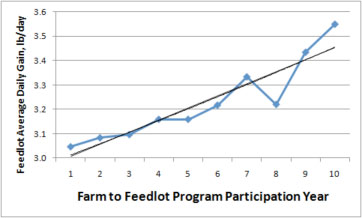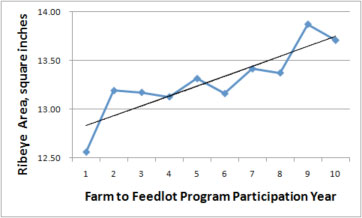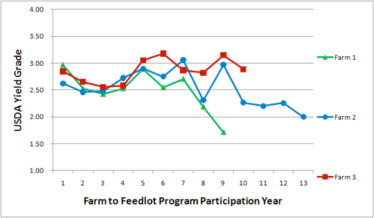 |
February 2012
|
February 2012 // Volume 50 // Number 1 // Tools of the Trade // v50-1tt6
Performance-Based Evaluation of a Beef Cattle Retained Ownership Extension Program
Abstract
Feedback from participants in Extension programs is often favorable. However, some of these participants do not adopt the management changes recommended through a specific Extension program. The evaluation reported here assessed producer adoption of management recommendations from the Mississippi Farm to Feedlot Program. This program facilitates cattle finishing and carcass data collection and then assists beef cattle producers in interpreting and using this information to make needed management changes. Farm-level and aggregate results reveal areas where improvements are needed and document the rate of adoption of recommendations. This can help Extension professionals modify programming efforts to improve program impact.
Introduction
Feedback from participants in Extension programs is often favorable. However, some of these participants do not adopt the management changes recommended through a specific Extension program. Accurate assessment of the educational value of a program should address program impact. Confirmation of adoption or non-adoption of management changes based on program recommendations can help Extension professionals modify programming efforts to improve program impact.
Farm to Feedlot Program Participation
The Mississippi Farm to Feedlot Program is one of several cattle feeding data collection projects offered as Extension programs in the United States (Parish & McKinley, 2005). Beef cattle producers participating in the Mississippi Farm to Feedlot Program retain ownership of calves through the finishing period. Feedlot average daily gain, calf health performance, carcass trait, and financial data are collected. Primary objectives of this project are to facilitate this data collection and then to assist beef cattle producers in interpreting and using this information to make needed changes in their breeding, health, and management programs. The objective of the program evaluation reported here is to assess implementation of breeding and genetics recommendations.
From 1993 to 2006, 7,295 head of steers and heifers representing 203 unique farms of origin completed the Mississippi Farm to Feedlot Program. Of the 203 farms participating in the program over this period, 31 farms participated for at least a 5-year period, and seven farms participated for at least a 10-year period. Records of 3,873 steers from the 31 farms utilizing the program for a minimum of 5 years were used in this evaluation.
Review of the farm participation statistics is revealing. From the time data feedback is received from the first year of program participation, changes made to health and management practices on-farm affect subsequent program results in the following program year. However, changes made to breeding practices on-farm do not affect subsequent program results until at least the fourth program year. This is because there is a significant lag in time from when the initial program results are received by the producer, used to make changes to breeding and genetics programs, and then the resulting calf crop is weaned and ready to enter the Mississippi Farm to Feedlot Program. Therefore, for producers to identify needed genetic changes and then observe the results of these changes through this program, they must participate for a minimum of 4 years.
Thirty-one farms, 15% of the total number of Mississippi Farm to Feedlot Program farms, stayed active in the program for at least the 4-year period needed to identify, implement, and document breeding and genetics changes through the program. There is still the possibility that some of the other 85% of farms with shorter tenures in the program used the program feedback to make breeding and other management changes that were documented outside the program. Follow-up surveys with individual farms are needed to determine this.
Documentation of Management Changes
Several notable trends were documented among the long-term Mississippi Farm to Feedlot Program participants. Collective calf feedlot entry weight tended to increase by 5 pounds per head for every additional year of program participation (Figure 1). Feedlot average daily gain tended to increase 0.05 pounds for every subsequent year of program participation on aggregate (Figure 2). Overall, beef carcass ribeye area tended to increase 0.10 square inches for every additional year of program participation (Figure 3). Collective beef carcass USDA Yield Grade tended to decrease by 0.03 units per head for every additional year of program participation (Figure 4). Within this group, the percentage of carcasses meeting industry standards for USDA Yield Grade, USDA Yield Grade numerically equal to or less than 3.5, increased from 81% to 91% over 10 years of program participation. These results indicate that, in general, program participants selected for heavier calves at feedlot entry, with higher growth performance and lean muscle yield. This is consistent with program recommendations for these traits.
Figure 1.
Calf Feedlot Entry Weight Trend

Figure 2.
Calf Feedlot Average Daily Gain Trend

Figure 3.
Beef Carcass Ribeye Area Trend

Figure 4.
Beef Carcass USDA Yield Grade Trend

Inconsistent results were documented for marbling score and USDA Quality Grade values over 10 years of program participation. Similarly, only approximately one-third of these beef carcasses met industry standards, USDA Choice or better, for USDA Quality Grade. Although individual farms may have placed selection emphasis on improving marbling and USDA Quality Grade, the aggregate results do not show definitive trends.
The importance of assessing program results on an individual farm, rather than aggregate, basis is evident in Figure 5. This illustration shows the USDA Yield Grade trends for three farms. Although program results appear similar for the first 5 years of program participation amongst these farms, notable variation appears beyond this period. Farm 1 made the most improvement in USDA Yield Grade and did it in the shortest period of time. Farm 2 improved on USDA Yield Grade, but most of this improvement comes after the ninth program year. Farm 3 did not improve USDA Yield Grade over 10 years.
Figure 5.
Beef Carcass USDA Yield Grade Trend by Farm

Conclusions
Analysis of Mississippi Farm to Feedlot Program results shows that at least a subset of program participants implemented some of the recommended breeding management practices. Specifically, program participants improved calf growth performance and lean muscle yield on aggregate. The overall impact of the program on beef cattle producers is difficult to quantify because some non-participant program observers may have adopted improved management practices based on public program information.
References
Parish, J. A., & McKinley, W. B. (2005). Use of a cattle feeding profitability prediction contest in beef Extension programming. Journal of Extension [On-line], 43(4) Article 4IAW4. Available at http://www.joe.org/joe/2005august/iw4.php




